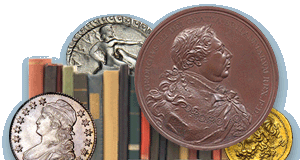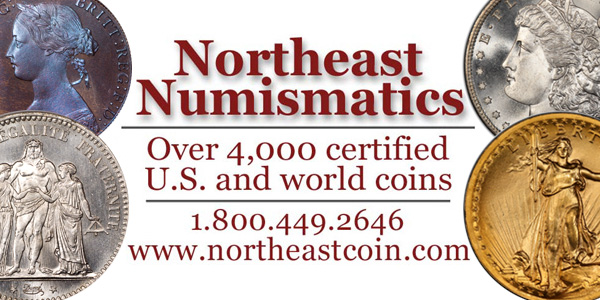
PREV ARTICLE
NEXT ARTICLE
FULL ISSUE
PREV FULL ISSUE
BOB LEONARD ON THE MAINE PENNYBob Leonard submitted this note on the Maine Penny. Thanks. -Editor I first learned of this find in the December 1978, when it was illustrated on the cover of that issue of Seaby Coin & Medal Bulletin. I immediately wrote to Dr. Bruce J. Bourque of the Maine State Museum in Augusta to buy a copy of Maine Arch. Soc. Bulletin, 18 (1978), no. 1, but it was already out of print and I was sent a Xerox copy instead. [Incidentally, this has to be one of the rarest American numismatic publications.] So I have first-hand information on the circumstances of the find. One of the problems with the "Maine Penny" is that it is VERY much embrittled, and pieces have chipped off over time to the point where it is all but unrecognizable as a coin. Here is how it looked at first publication: (Also see photo in Seaby Coin & Medal Bulletin.) It is clear that this started off as a round coin that was pierced for wearing on a necklace and first broke when one of the natives was tossing out the garbage. As we know, it was not found again until picked up by one of two relic hunters, Guy Mellgren or Ed Runge, in August 1961. They were going through an ancient shell midden with an abundance of seal remains, looking for artifacts, when it was spotted. "As the dust and humus were cleaned off, definite markings became visible."--Bert E. Farmer, "Were the English the First to Discover America," Maine Arch. Soc. Bulletin, 18 (1978), no. 1. They thought it was an English coin as can be seen from the title, and sent it to the "A.N.A. - American Numismatic Association" for identification. At this point unfortunate confusion between the ANA and the ANS arises: "When the report from the American Numismatic Society came back, it was brief and to the point: the coin was identified as English, minted between 1134-1154 A.D." The notion that these two amateurs somehow obtained and planted a rare Norse coin, after embrittling it, only to have it misattributed as English, is utterly preposterous. This report MUST be taken at face value. How then to explain the appearance of a coin minted between 1065-1080 in a site now dated to 1180-1235? No doubt there were visits to Vinland not memorialized in sagas, but the 12th century is after the Viking period. Was this coin a century-old heirloom? In the 19th century, and perhaps centuries earlier, Inuit and Indians got together in the summer in northern Canada to trade. There was a Norse settlement in Greenland as late as the 13th century, and the Norse traded with the Inuit. Was an obsolete coin traded to an Inuit, taken west to Canada years later, then traded to an seal-hunting Indian and taken back to the coast? Neither explanation seems very probable. Perhaps additional research (bead studies?) will clarify matters.
To read the complete article, see:
Wayne Homren, Editor The Numismatic Bibliomania Society is a non-profit organization promoting numismatic literature. See our web site at coinbooks.org. To submit items for publication in The E-Sylum, write to the Editor at this address: whomren@gmail.com To subscribe go to: Subscribe All Rights Reserved. NBS Home Page Contact the NBS webmaster 
|

